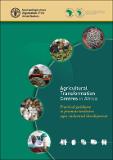
Book/Monograph
Agricultural Transformation Centres in Africa - Practical guidance to promote inclusive agro-industrial development
Attachments [ 1 ]
More Details
Over the next ten years, the African rural space will be the theatre of profound changes as the activities envisaged for agricultural transformation are drastically scaled up. Increased food demand and changing consumption habits driven by demographic factors, such as population growth and urbanization, are already leading to a rapid increase of net food imports, opening a huge opportunity for the agribusiness sector of many African countries. Against this backdrop and in line with its mission to spur sustainable economic development and social progress, the African Development Bank (AfDB) in 2016 launched Feed Africa, a strategy that is intended to contribute substantially to the transformation of African agriculture by 2025, and to reverse Africa's dependence on imported foods. As part of this strategy, AfDB is promoting the concept of staple crops processing zones (SCPZs), which are agrobased spatial development initiatives, designed to concentrate agro-processing activities within areas of high agricultural potential to boost productivity and integrate the production, processing and marketing of selected commodities. As essential components, SCPZs include an agro-processing hub, a number of agricultural transformation centres (ATCs) and agricultural production areas. The ATCs are designed to link smallholder farmers to the agro-processing hub and are strategically located in high production areas, with the aim of serving as aggregation points to accumulate products from the community to supply the hub for further value addition, or to send them to centres of great demand for distribution and retail to consumers. This study has attempted to assess the feasibility and applicability of the ATC concept to selected regions in Zambia, Cote d'Ivoire and the United Republic of Tanzania. Findings from the field have demonstrated the potential of ATCs to address community needs and constraints for a range of selected value chains, and have helped to identify different ATC models that could work in each specific context.
Comments
(Leave your comments here about this item.)